I created this Mixed Grain Miche to test a new stoneware baker and use some of the rye and whole wheat flours I got from Carolina Ground a few weeks ago.
This miche-style bread is made with an overnight poolish instead of a sourdough levain. I wanted to bake bread and because I hadn’t fed my sourdough starter recently, I decided that utilizing a poolish was the easiest way to go.
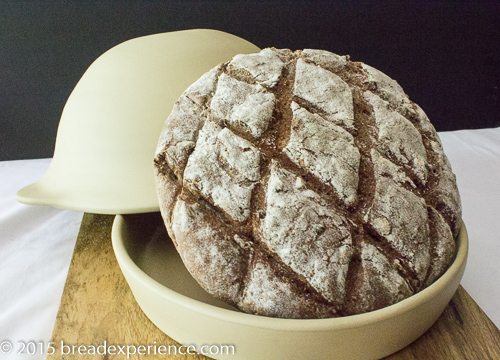
The loaf fits perfectly in my new handmade-in-America bread cloche from Emerson Creek Pottery. I’ve had this baker for a couple of weeks, but my schedule has been so hectic I didn’t get a chance to test it right away. I had been itching to bake some bread in it so I decided to create a special bread with Carolina Ground flour.
The overnight poolish is made with 50% T75 whole wheat and 50% rye flour and the final dough contains whole wheat, rye, and about 20% bread flour. I probably could’ve omitted the white bread flour altogether, but at the last minute, I decided to include a small percentage.
The loaf baked wonderfully in this cloche. I sprinkled the bottom heavily with cornmeal and then flipped the dough gently from the banneton basket onto the bottom of the baker. It didn’t quite land in the middle and at first, I was going to leave it like that because I figured it would stick to the bottom and get misshapen if I tried to readjust it. However, I decided why not and gave it a light shake to see if it would readjust itself to the middle of the baker. It moved effortlessly and didn’t stick to the bottom of the baker at all. I was very pleased indeed.
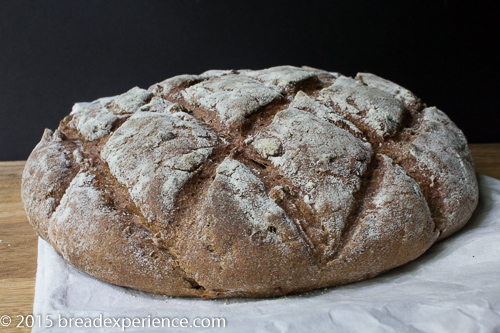
My inspiration for this miche came from the Mixed-Flour Miche using a Levain in Bread by Jeffrey Hammelman, and Sourdough Rye Bread with Walnuts from The Fundamental Techniques of Classic Bread Baking The French Culinary Institute.
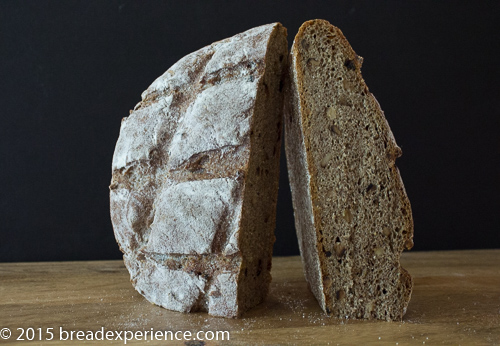
This bread has a toasty and nutty flavor due to the walnuts. The whole wheat and rye flours provided a beautiful color and wheaty flavor without being overpowering. I enjoyed slices toasted with butter and as a peanut butter and jelly sandwich. It also tastes good as cheese toast.
Print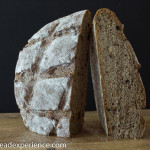
Mixed Grain Miche with Poolish
- Yield: 1 Loaf 1x
Description
Miche-style loaf made with a poolish and baked in an unglazed stoneware cloche.
Ingredients
Overnight Poolish
- 125 grams Whole Wheat flour
- 125 grams Rye flour
- 250 grams Water
- 1/8 tsp. Instant yeast
Final Dough
- 150 grams Whole Wheat Flour
- 50 grams Rye Flour
- 50 grams Bread Flour
- 162.5 grams Water
- 1 1/2 tsp. Yeast
- 1 3/4 tsp. Salt
- All of the poolish
- 100 grams Toasted walnuts
Instructions
Making the poolish
- In a mixing bowl, whisk together the rye and wheat flours and yeast and gradually add in the water. Stir with a wooden spoon or Danish dough whisk until the mixture is completely blended. Cover the bowl with plastic wrap and let the poolish rest overnight at room temperature (70 degrees F.) for 8 to 12 hours.
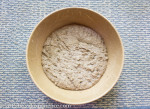
Making the final dough
- In the bowl of a stand mixer, whisk together the flours, yeast and salt. Add in the poolish and the water and mix on low speed using the dough hook just until blended. Increase to medium speed and mix the dough for about 5 to 10 minutes, or until the dough begins to pull away from the sides of the bowl. It should feel elastic at this point. Add in the walnuts on low speed.
- Shape the dough into a ball and transfer to a lightly oiled large bowl. Cover the dough with plastic wrap and let it proof for 1 hour at room temperature.
- Transfer the dough to a lightly floured work surface. Shape into a rough ball, cover with plastic wrap or a kitchen towel and let it bench rest for 15 minutes.
- Lightly flour a lined banneton (proofing basket) with white rice flour.
- Shape the dough into a tighter round and place it in the banneton basket seamside up.
- Cover with plastic wrap again and let it proof for 1 hour.
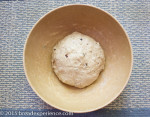
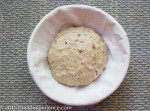
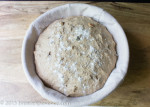
- While the loaf is proofing, preheat the oven to 450 degrees F. with the cloche on the bottom rack. Allow the oven and the cloche to preheat for at least 45 minutes.
- Carefully remove the preheated cloche from the oven using heavy oven mitts. Place the lid on a heavy towel or pot holder to keep it from cracking from the temperature change. Put the bottom on another towel or pot holder. Sprinkle the bottom of the baker with cornmeal.
- Flip the loaf from the proofing basket to the bottom of the baker.
- Using a lame or serrated knife, score the loaf in the pattern of your choice.
- Transfer the bottom of the baker to the oven and place the lid on top. Let the loaf bake for 30 minutes with the lid on; then remove the lid and let it bake another 15 to 20 minutes or until it is a deep brown and sounds hollow when thumped on the bottom.
- Remove the loaf from the oven and transfer to a wire rack to cool completely before slicing.
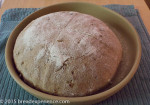

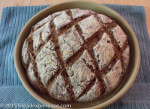
Notes
When you remove the lid, be sure to place it on a heavy towel or pot holder to prevent it from cracking due to temperature change.
- Category: Artisan Loaf
Happy Baking!
Cathy
Disclaimer: I received a baking cloche from Emerson Creek Pottery for this review. Thank you Heather for the opportunity to test this baker. I enjoyed using this cloche and look forward to baking more loaves in it.
Joyce says
Hi,
I have active sourdough starters, one white and one whole wheat. I would like to use it in this recipe but don’t know how much or when to use it. Can you help me? Thanks Joyce
Cathy says
Hi Joyce, you could use about 10% of your active starter in place of the yeast in the poolish. So add 25 grams of starter to the 250 grams of whole grain and rye flours and mix with the water and let it rest for 8 to 12 hours. Then continue with the final dough.
Sabrina Brown says
Hi, is the amount of the flour for the dough correct, please? When I add up the gram measurements for the poolouche and the dough it only comes to 450 grams or two cups of flour in total, which seems low for the final bread loaf, which looks quite large.
Many Thanks,
Sabrina
Cathy says
Hi, Thank you for your inquiry. The total flour in this bread is 500 grams which is a little over 4 cups. When you factor in the water, it is a fairly big loaf.
Here is the breakdown of the flour: 250 grams total flour in the poolish (125 grams whole wheat & 125 grams rye flour) and 250 grams total flour in the final dough (150 grams whole wheat flour, 50 grams rye and 50 grams bread flour.
I have reordered the ingredients in the final dough to show the largest amount of flour first. Hopefully, this will help.
Happy Baking!
Cathy